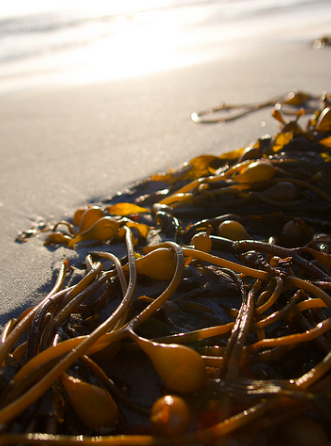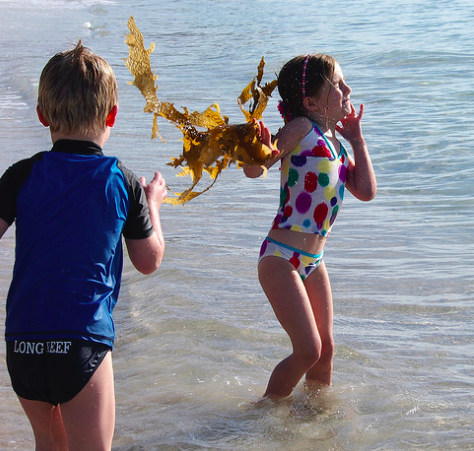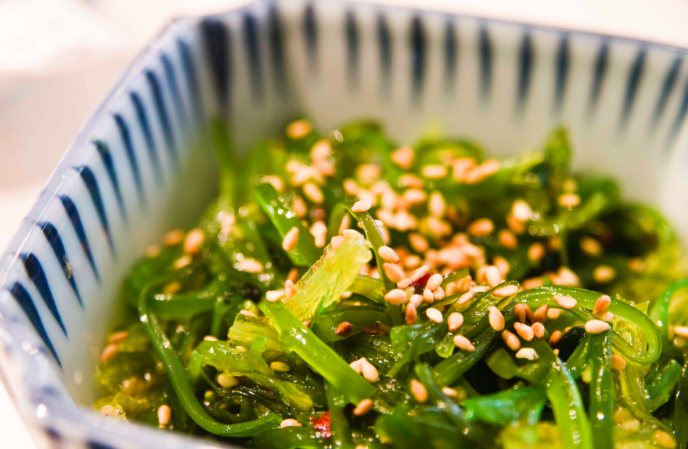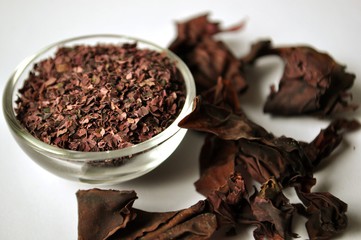Seaweed is a sensational source of goodness and is well known to the frugal gardener. Less well known is its use in the frugal kitchen.
 There are lots of good things about seaweed – a main one being that it’s free! It can be collected while on a family outing to the beach. One lucky oily ragger happens to live near a beach and looks forward to the seaweed harvest that inevitably washes up after rough seas. Their latest haul of four trailer loads just a few weeks ago, has already been put to a multitude of uses.
There are lots of good things about seaweed – a main one being that it’s free! It can be collected while on a family outing to the beach. One lucky oily ragger happens to live near a beach and looks forward to the seaweed harvest that inevitably washes up after rough seas. Their latest haul of four trailer loads just a few weeks ago, has already been put to a multitude of uses.
For the garden
To make a “seaweed soup” for the garden, a reader recommends placing dried and crushed seaweed into a 44 gallon drum which is filled with water and left to brew for six weeks or so. It turns into a lovely syrup, which can then be diluted (10 parts water to one part syrup) and applied to fruit trees and vegetable plants. To dry the seaweed they place it on racks in the direct sunlight until it is “crispy dry”. They then half fill a sack and stomp on it until the seaweed has been crushed into small bits. The smaller the pieces the better it will mix in with the water. They store the concentrate until it’s needed then dilute it to use. The soup is also an excellent general liquid fertiliser for all indoor plants – no need to buy the expensive mixtures being sold commercially.
Seaweed can also be used as a mulch around trees and plants. Not only will it help to retain moisture in the soil, but as it breaks down, it becomes a broad spectrum fertiliser, rich in trace elements. Apply about 100mm thick and away from the stems. This is a great way to minimise the need to water in summer. It’s also a natural repellent to slugs – because of the salt content and sharp edges when dry.
 To apply it directly into garden beds, place it in the bottom of trenches or plant holes. This is a great way to get fertiliser to the roots of the plants.
To apply it directly into garden beds, place it in the bottom of trenches or plant holes. This is a great way to get fertiliser to the roots of the plants.
Seaweed can also be placed directly into the compost bin. It’s treated as “green” matter so needs to be mixed or layered with “brown” material like dead leaves.
Another reader says that over the winter they place loads of seaweed directly onto their pumpkin patch. Not only is it a source of compost when needed, but the pumpkins thrive on it and grow into monsters!
Although there will be traces of salt in the seaweed, the general opinion seems to be that it’s not sufficient to affect the soil.
Here are some things you may not know about seaweed in the kitchen
 Seaweed is the vegetable of the sea. There are thousands of different types of seaweed generally grouped by colour: reds, browns and greens. About 800 are indigenous to New Zealand but only a few types (red and green) are used for eating.
Seaweed is the vegetable of the sea. There are thousands of different types of seaweed generally grouped by colour: reds, browns and greens. About 800 are indigenous to New Zealand but only a few types (red and green) are used for eating.
The red varieties are much smaller than the brown, growing up to about 30 cm long. The best-known red is the edible Karengo which grows on rocks near the high-tide level. It looks like light purple cellophane. It is related to nori which the Japanese use for sushi. Karengo can be prepared fresh by boiling in a small amount of salted water with 1 tablespoon butter for 20 to 30 minutes. It’s delicious with corned beef.
The most common green variety is sea lettuce which attaches to rocks but is often seen washed up on shores after a decent storm. It looks like green tissue paper – and is about as appetising – but is full of vitamins and minerals.
 It can be eaten fresh, but is usually dried and used like a chopped herb with fish, in soups, sauces, and dips, as a pizza topping, or sprinkled on salads and vegetables like boiled or baked potatoes.
It can be eaten fresh, but is usually dried and used like a chopped herb with fish, in soups, sauces, and dips, as a pizza topping, or sprinkled on salads and vegetables like boiled or baked potatoes.
The best way to harvest it is to pick the outside leaves of the plant, wash them in fresh water to remove the salt, then hang them on the clothesline to dry (that will get the neighbours talking!).
An oily rag reader writes, “I make sea lettuce chips. I cut a dried sea lettuce leaf into potato chip-sized pieces and deep fry them until they are crisp. Yum.”
By Frank and Dr Muriel Newman.
Read more Oily Rag articles here.
You can contact the Oily Rag community via the website at oilyrag.co.nz or by writing to Living off the Smell of an Oily Rag, PO Box 984, Whangarei.










Join the Discussion
Type out your comment here:
You must be logged in to post a comment.